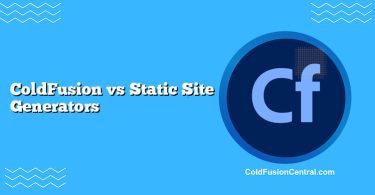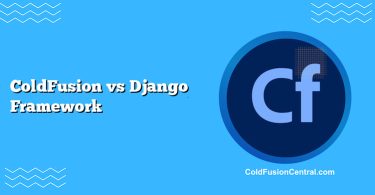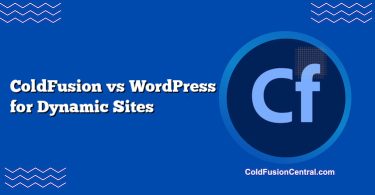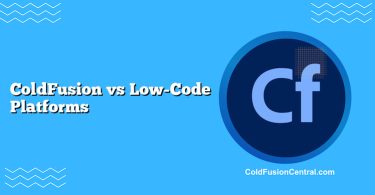Definitions
-
ColdFusion (CFML runtime): A commercial application server and rapid web development platform from Adobe (and compatible open-source implementations like Lucee) that executes applications written in CFML (ColdFusion Markup Language). It provides built-in services such as PDF generation, mail, caching, scheduling, database access, and REST, along with enterprise features and an integrated administrator.
-
ColdBox Framework: An open-source, opinionated MVC (Model-View-Controller) framework for building CFML applications. Created by Ortus Solutions, ColdBox adds routing, dependency injection (WireBox), modularity, interception, conventions, testing (TestBox integration), and many productivity tools. It runs on top of CFML engines such as Adobe ColdFusion (ACF) and Lucee.
Overview: How They Relate (and Differ)
ColdFusion and ColdBox are not direct substitutes. ColdFusion is the runtime platform and language ecosystem (CFML engine) used to run your code. ColdBox is an application framework used within that runtime to structure and organize your code following modern software architecture patterns.
Think of it this way:
- ColdFusion (or Lucee) = the engine and core services.
- ColdBox = the framework and patterns you use on that engine to deliver scalable, maintainable applications.
You can write CFML apps without ColdBox (or any framework). You can also write CFML apps with ColdBox to gain conventions, MVC, routing, DI, testing, and modularity.
Architecture Differences (H3)
- ColdFusion:
- Provides built-in tags and functions (CFML), application lifecycle (Application.cfc), and enterprise features (scheduler, caching, PDF, WS, mail).
- You design the architecture yourself or use minimal conventions.
- ColdBox:
- Provides MVC conventions (handlers, views, layouts), routing, interceptors, modules, and a cohesive, testable architecture on top of CFML.
- Integrates with WireBox (DI), CacheBox, LogBox, and various modules (e.g., cbSecurity, qb/Quick, cbORM).
Key Features
ColdFusion: Platform Features (H3)
- CFML language with tag and script syntax.
- Comprehensive built-in services: mail, PDF, spreadsheet, image, websocket, REST, scheduling.
- Integration with ORM (Hibernate-based), CFThread for concurrency, CFDocument for PDFs, CFHTTP, and more.
- Administrator UI for data sources, caching, security, and server tuning.
- Enterprise features with optional add-ons (e.g., Performance Monitoring Toolset in ACF).
- Commercial support from Adobe; alternative open-source engine Lucee offers many similar features.
ColdBox: Framework Features (H3)
- MVC routing and conventions (handlers, views, layouts).
- Dependency Injection via WireBox and AOP/interceptors.
- Modular architecture (reusable ColdBox modules from ForgeBox).
- TestBox integration for unit, integration, and BDD-style tests.
- Built-in logging (LogBox), caching (CacheBox), and internationalization features.
- First-class REST API support (routing, interceptors, security).
- CommandBox integration for scaffolding, dev servers, deployments, and package management (ForgeBox).
Performance
-
ColdFusion engine performance:
- ACF is optimized for enterprise workloads with JIT compilation and robust caching options. Warm-up time matters; after warm-up, throughput is high.
- Lucee is known for speed and memory efficiency, often favored for high-throughput, cost-sensitive environments.
-
ColdBox overhead:
- Adds a thin layer of routing, DI, and conventions. After first-load warm-up (DI wiring, module loading), framework overhead is small relative to app logic.
- Encourages caching, async patterns, and modularity that often improve real-world performance.
- Using features like CacheBox, scheduled tasks via CommandBox or the engine scheduler, and optimized routing keeps response times competitive.
-
Practical tip:
- Profile with built-in performance tools (ACF PMT) or Lucee’s admin metrics.
- Cache expensive queries and views; leverage ColdBox’s interception points and CacheBox.
Scalability
- Vertical scaling: ColdFusion engines can be tuned with JVM options, connection pools, and caching. ColdBox’s stateless handlers lend themselves to horizontal scaling as well.
- Horizontal scaling: Use multiple instances behind a load balancer. Sticky sessions can help, or externalize session/state (e.g., Redis) with ColdBox session storage modules.
- Microservices and modular monoliths: ColdBox’s modules, interceptors, and DI make it easier to break apps into services or deploy modules independently over time.
- CI/CD: CommandBox makes containerization and automated builds straightforward; ColdBox apps are convention-driven, which simplifies pipelines.
Security
- ColdFusion security:
- Built-in CSRF, XSS protection helpers, secure session management, sandboxing, and administrator controls.
- Integration with enterprise SSO, LDAP, and TLS.
- ColdBox security:
- Modules like cbSecurity for authentication/authorization, JWT support, rule-based security, and interception points for custom policies.
- Centralized request lifecycle enables consistent validation, input sanitization, and rate limiting via interceptors.
Best practice: combine the engine-level protections (ACF or Lucee) with ColdBox security modules and consistent coding standards. Keep both engine and framework updated.
Developer Experience and Productivity
- ColdFusion:
- Rapid development with CFML tags, script syntax, and out-of-the-box services.
- Great for smaller apps or teams accustomed to tag-based coding and minimal structure.
- ColdBox:
- Predictable conventions, consistent routing, and DI patterns accelerate large-team collaboration.
- Rich tooling: CommandBox for scaffolding and local servers; TestBox for testing; ForgeBox for sharing modules.
- Easier onboarding for developers coming from MVC frameworks in other ecosystems.
Cost and Licensing
- Adobe ColdFusion (ACF): Commercial licenses (Standard/Enterprise). Includes PMT and enterprise support. Good fit for organizations requiring vendor-backed SLAs and official support.
- Lucee: Open-source CFML engine with optional commercial support via third parties.
- ColdBox: Open-source (Apache 2.0) by Ortus Solutions; optional commercial support/training available.
- Net effect:
- ColdBox adds no licensing cost; it can reduce total cost of ownership by improving maintainability and testability.
- Engine choice (ACF vs Lucee) impacts licensing most.
Community and Ecosystem
- ColdFusion:
- Adobe forums, CF Summit, CFML Slack, blogs, Stack Overflow.
- Mature ecosystem with enterprise users and long-running production deployments.
- ColdBox:
- Active open-source community, ForgeBox module registry, comprehensive docs, and regular updates from Ortus Solutions.
- Companion projects: CommandBox (CLI/server), TestBox, WireBox, CacheBox, LogBox, qb/Quick (query builder/ORM), cbRest/cbSecurity.
Real-World Use Cases and Scenarios
When to Choose ColdFusion (standalone or light framework) (H3)
- Rapid prototyping with minimal structure: small internal tools or reports, where speed-to-first-delivery matters more than long-term architecture.
- Legacy CFML apps that are stable and rarely changed; adding a heavy framework may not provide immediate ROI.
- Organizations relying on Adobe enterprise features and official support contracts, using ACF’s PMT and admin tooling.
Example: A department needs a quick data-entry app with PDF export and scheduled email reports. ACF’s built-in PDF and scheduler deliver value quickly without introducing a full MVC stack.
When to Choose ColdBox on ColdFusion or Lucee (H3)
- Building maintainable, testable applications at scale: enterprise portals, REST APIs, large content platforms, and multi-team projects.
- Migrating a legacy CFML codebase to modern architecture, with DI, modules, and clear separation of concerns.
- Deploying CI/CD pipelines, containers, and cloud-native patterns using CommandBox and ForgeBox modules.
Example: A multi-team e-commerce platform with REST APIs, caching layers, background jobs, and feature modularity. ColdBox provides routing, DI, security, and testing; the team runs on Lucee for cost efficiency or ACF for enterprise support.
Side-by-Side Comparison Table
| Category | ColdFusion (ACF/Lucee) | ColdBox Framework |
|---|---|---|
| What it is | CFML runtime/platform | MVC framework for CFML |
| Layer | Server engine and services | Application architecture on top of engine |
| Performance | High throughput after warm-up; engine-level caching | Minimal overhead; adds caching/DI/routing that often improves real-world performance |
| Scalability | JVM tuning, clustering, load balancing | Encourages stateless design, modularization, DI; easy horizontal scaling |
| Security | Engine-level protections, admin controls | cbSecurity, JWT, interceptors; consistent policy enforcement |
| Cost | ACF licensed; Lucee free/OSS | Free/OSS (Apache 2.0) |
| Use cases | Small apps, rapid prototypes, enterprise features | Medium–large apps, REST APIs, long-term maintainability |
| Pros | Built-in services, mature, enterprise support | Conventions, testing, DI, modules, developer productivity |
| Cons | Risk of ad hoc architecture and spaghetti code | Learning curve; requires buy-in to conventions |
| Testing | Possible but ad hoc without framework | First-class with TestBox and integration testing |
| DevOps | ACF admin/PMT; Lucee admin; container images available | CommandBox-driven workflows, ForgeBox packages, easy containerization |
Pros and Cons
ColdFusion (H3)
Pros:
- Rapid development with built-in tags/functions and services (PDF, mail, scheduler).
- Mature platform with strong enterprise features and tooling.
- Commercial support (ACF) and stable ecosystem.
Cons:
- Without a framework, architecture is left to each team; risk of unstructured code.
- ACF licensing costs may be significant; Lucee reduces cost but requires community/third-party support.
- Testing, modularity, and DI patterns require extra effort without a framework.
ColdBox (H3)
Pros:
- Clear MVC conventions, routing, DI (WireBox), and modularity.
- First-class testing with TestBox; easier maintainability and onboarding.
- Rich ecosystem (ForgeBox modules), strong tooling (CommandBox).
- Improves code quality, consistency, and scalability.
Cons:
- Learning curve for teams new to MVC, DI, and interception.
- Slight startup overhead from DI wiring and module loading (mitigated after warm-up).
- Requires buy-in to conventions and refactoring for legacy codebases.
Decision Factors / Which One Should You Choose?
- Team size and longevity:
- Small, short-lived internal apps: ColdFusion alone may suffice.
- Multi-developer, evolving systems: ColdBox provides structure and testability.
- Budget and support:
- Need official enterprise support: Adobe ColdFusion + ColdBox.
- Cost-sensitive, open-source preference: Lucee + ColdBox.
- Maintainability and testing:
- If refactoring, versioning, and CI/CD matter, ColdBox is a strong choice.
- Performance and scale:
- Both can perform well. ColdBox often improves real-world performance through caching and better separation of concerns.
- Migration path:
- Legacy CFML can gradually adopt ColdBox (start with routing, then introduce DI, then modules).
In short: choose your engine (ACF or Lucee) based on budget and support needs; choose ColdBox when you want long-term maintainability, modern architecture, and team productivity.
Step-by-Step: Modernizing a Legacy CFML App with ColdBox
- Baseline and tests:
- Identify critical flows and write a few TestBox tests (even smoke tests) to guard against regressions.
- Introduce CommandBox:
- Run the app locally with CommandBox, manage dependencies via ForgeBox, and standardize dev environments.
- Add ColdBox routing:
- Start by proxying existing URLs through ColdBox routing. Create simple handlers that delegate to legacy code.
- Extract services and DI with WireBox:
- Move business logic into service components. Inject these into handlers. Replace global variables with controlled dependencies.
- Modularize:
- Group related features into ColdBox modules. Encapsulate routes, handlers, views, and services. Consider shared libraries for cross-cutting concerns.
- Implement security and caching:
- Add cbSecurity for authentication/authorization. Use CacheBox to cache expensive operations.
- Expand testing and CI/CD:
- Increase TestBox coverage. Add automated builds and containerization with CommandBox. Deploy consistently across environments.
This incremental approach minimizes risk while progressively gaining the benefits of a modern CFML architecture.
Supported Platforms and Compatibility
- Engines:
- Adobe ColdFusion (various versions; check ColdBox compatibility matrix).
- Lucee CFML.
- Operating systems:
- Windows, Linux, macOS (JVM-based).
- Web servers:
- Built-in dev server via CommandBox; or IIS, Apache, NGINX with appropriate connectors.
- Databases:
- Any JDBC-compatible DB (MySQL/MariaDB, SQL Server, PostgreSQL, Oracle, etc.).
- Tooling:
- CommandBox CLI and server, TestBox, ForgeBox packages, Docker images for ACF/Lucee.
Key Takeaways
- ColdFusion (ACF/Lucee) is the CFML runtime; ColdBox is an MVC framework that runs on that runtime.
- Use ColdFusion alone for simple apps or quick prototypes; combine it with ColdBox for maintainable, testable, scalable systems.
- ColdBox’s DI, routing, modules, and testing significantly improve developer experience and long-term ROI.
- Cost is mainly driven by engine choice (ACF vs Lucee). ColdBox itself is free and open-source.
- The best stack for most serious applications is typically ColdBox on Lucee or ColdBox on ACF, depending on budget and support requirements.
FAQ
What is the difference between ColdFusion and CFML?
CFML is the language used to write code (tags and script). ColdFusion commonly refers to Adobe’s CFML engine (the server that runs CFML). Lucee is an open-source CFML engine alternative. Both execute CFML code; the term “ColdFusion” often means the Adobe product specifically.
Can I use ColdBox with Lucee instead of Adobe ColdFusion?
Yes. ColdBox is engine-agnostic and runs on both Lucee and Adobe ColdFusion. Many teams choose Lucee + ColdBox for cost efficiency and strong performance, while others pick ACF + ColdBox for enterprise support.
Does ColdBox replace ColdFusion’s built-in features?
No. ColdBox complements the engine. You still use CFML/engine features (datasources, caching, schedulers). ColdBox adds architecture, routing, DI, testing, and modules for better structure and productivity.
Is there a big performance penalty to using ColdBox?
Usually no. There is a small warm-up cost for DI wiring and module loading, but steady-state performance is typically similar or better because ColdBox encourages caching, separation of concerns, and efficient routing.
How hard is it to migrate a legacy CFML app to ColdBox?
You can do it gradually. Start by introducing ColdBox routing and handlers, then refactor business logic into services with WireBox, add testing with TestBox, and modularize over time. This staged approach reduces risk while improving maintainability.




